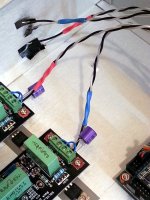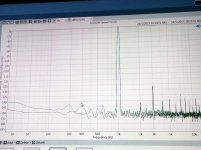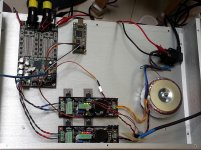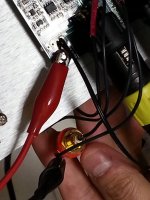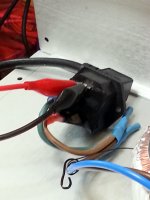Here is a challenge that might keep you occupied while you are waiting for a response:
Find one example of commercial audio product where the vendor gives an exact log of fixes included in a firmware update before the update is released or a time schedule for when the update will be released.
It might take you a while, because no-one I know of is stupid enough to do so...
No product is perfect.
I believe most users will accept bug fix and improvement by phase.
For example, We can see there are many fix release on audirvana Plus.
Release schedule is nice to have thing. I accept it even by the end of 2017.
No product is perfect.
I believe most users will accept bug fix and improvement by phase.
For example, We can see there are many fix release on audirvana Plus.
Release schedule is nice to have thing. I accept it even by the end of 2017.
Audirvana is a good example. How many bug fix releases have there been over the past month? 2 or 3 or is it more? I've lost track... I'd rather a well sorted release than a rushed update followed but countless bandaid bug fixes. I'm sure most of us would prefer not to be faced with two bug fixes a week....
I believe that there is a lot of low level code that needs to be added or changed to enable cross overs and other features that were proposed for the next firmware. With substantial low level changes like this to software it is difficult if not impossible to do incremental updates.
Even with Audirvana v1 development ceased when work started on v2 and I recall complaints from users about lack of bug fixes to v1. This is no different. Let Soren get on with the stuff that matters - working his magic on the firmware. I'd much more concerned if I saw him dropping tools to get on the forum to answer every question that gets posted..
As for the commercial product think of it as an OEM type of thing and you'll be closer to the reality. Soekris is a component business that designs manufactures and sells parts to technical knowledgable consumers that have sufficient skills to deal with bolting together network computers to suit their needs. That market expects and gets reliable hardware. Frequent bug fixes create big issues when you have boxes installed in multiple sites that have to be patched several times a week. Expect Soren to apply same philosophy of infrequent but well sorted updates to the DAM.
Note for using BiB Shunt Reg for Dam1021
Yesterday, we tested the dac + BiB comb with an APx-515.
We identified several things which other DIYers (using BiB Shunt reg) need to pay attention to.
1. one may add cap at the output of BiB Shunt Reg (see pic below)
2. do not use remote sensing
After these two modification, FFT analysis showed that there was a drop in noise floor of about 20dB. Yes! 20dB! Simply by looking at the FFT graph, we founded that there was also slight improvement in harmonic distortion too.
Yesterday, we tested the dac + BiB comb with an APx-515.
We identified several things which other DIYers (using BiB Shunt reg) need to pay attention to.
1. one may add cap at the output of BiB Shunt Reg (see pic below)
2. do not use remote sensing
After these two modification, FFT analysis showed that there was a drop in noise floor of about 20dB. Yes! 20dB! Simply by looking at the FFT graph, we founded that there was also slight improvement in harmonic distortion too.
Attachments
Note on Ground
Although it sounds like a cliche to most of the members here,
we have to iterate that the grounding makes a real difference
in the Dam 1021's performance.
My Dam1021 had not put into a chassis. I put everything into a chassis
a day before I picked it to my friend's home, (he has an APx-515).
Everything did not connect to the chassis ground. The ac power ground
was not connect to the chassis (DON'T try it at home!!!).
We found that grounding the bolt near the left output
(see the red crocodile clip in pic) is the most effective in reducing noise due
to interference. Of course, it may relate to how one places the PCB boards
inside the chassis.
Although it sounds like a cliche to most of the members here,
we have to iterate that the grounding makes a real difference
in the Dam 1021's performance.
My Dam1021 had not put into a chassis. I put everything into a chassis
a day before I picked it to my friend's home, (he has an APx-515).
Everything did not connect to the chassis ground. The ac power ground
was not connect to the chassis (DON'T try it at home!!!).
We found that grounding the bolt near the left output
(see the red crocodile clip in pic) is the most effective in reducing noise due
to interference. Of course, it may relate to how one places the PCB boards
inside the chassis.
Attachments
Stepped Level Sweep
I forget the exact reason why we ran a stepped level sweep analysis.
We repeated the test several times to ensure that the abnormal things is repeatable.
But we do find something that we are looking for.
There seems to be some abnormal things happened.
(see the first attachment).
In the region from -43dBFS to -36dBFS, the two channels move in different directions.
Distortion ratio of Channel 1 drops below -100dBFS while that of Channel 2 remains unchanged.
For Channel 2, there are 2 sharp tough near -36dBFS and -30 dBFS.
For a detail stepped level sweep analysis, please refer to page 51 to 67.
The graph in page 53 shows the abnormal step response clearly.
We are speculating about some error in the firmware or the filter.
We tried to download another filter to the DAC,
but we fail to use a putty in windows 7. So, we cannot determine
the cause.
Note: All the AP test were done with a DAM 1021 0.05% version and the 1013_C170_MP filter.
Also, the impulse response analysis shows that the C170_MP filter is using MP for 44.1kHz and LP for 96kHz.
Is it?
I forget the exact reason why we ran a stepped level sweep analysis.
We repeated the test several times to ensure that the abnormal things is repeatable.
But we do find something that we are looking for.
There seems to be some abnormal things happened.
(see the first attachment).
In the region from -43dBFS to -36dBFS, the two channels move in different directions.
Distortion ratio of Channel 1 drops below -100dBFS while that of Channel 2 remains unchanged.
For Channel 2, there are 2 sharp tough near -36dBFS and -30 dBFS.
For a detail stepped level sweep analysis, please refer to page 51 to 67.
The graph in page 53 shows the abnormal step response clearly.
We are speculating about some error in the firmware or the filter.
We tried to download another filter to the DAC,
but we fail to use a putty in windows 7. So, we cannot determine
the cause.
Note: All the AP test were done with a DAM 1021 0.05% version and the 1013_C170_MP filter.
Also, the impulse response analysis shows that the C170_MP filter is using MP for 44.1kHz and LP for 96kHz.
Is it?
Attachments
Last edited:
FFT at 1kHz
We compared the Dam1021 with a PCM1704 based DIY DAC.
At 0dBFS, the Dam 1021 shows higher distortion than PCM1704, about 10dB higher.
But, at -60dBFS, the Dam 1021 shows lower distortion than PCM1704, 10dB lower.
We are speculating that if Dam 1021 manages to produce much lower distortion at low
signal level than PCM1704, there may be some tricks that we can make it distortion lower at higher signal level.
The 67 pages AP report is too large to upload, only the FFT graphs under 96kHz sample rate are attached.
We compared the Dam1021 with a PCM1704 based DIY DAC.
At 0dBFS, the Dam 1021 shows higher distortion than PCM1704, about 10dB higher.
But, at -60dBFS, the Dam 1021 shows lower distortion than PCM1704, 10dB lower.
We are speculating that if Dam 1021 manages to produce much lower distortion at low
signal level than PCM1704, there may be some tricks that we can make it distortion lower at higher signal level.
The 67 pages AP report is too large to upload, only the FFT graphs under 96kHz sample rate are attached.
Attachments
We are speculating about some error in the firmware or the filter.
We tried to download another filter to the DAC,
but we fail to use a putty in windows 7. So, we cannot determine
the cause.
Note: All the AP test were done with a DAM 1021 0.05% version and the 1013_C170_MP filter.
Also, the impulse response analysis shows that the C170_MP filter is using MP for 44.1kHz and LP for 96kHz.
Is it?
Thanks for the measurements and the sharing Arthur! Regarding the filters, Paul has only been making them for 44k and 48k... because for the rest it's kind of like copying those settings to the other sample rates. Hence your experience there is right, if I understand everything right.
I'm using putty with windows 7 and don't have a problem. Maybe it is a driver issue with your serial adapter?
Although it sounds like a cliche to most of the members here,
we have to iterate that the grounding makes a real difference
in the Dam 1021's performance.
I don't have all your advanced instruments, but based on how the hardware has reacted when I connected different components to it, I believe the audio and signal ground is shared on the DAM1021. So if your PSU or succeeding output stage is connected to the chassis ground it's going to be linked anyways.
What I did is actually have a CL60 hooked up from my preamp's power supply to the chassis ground so everything is lifted by the ~8-10ohms.
Ristar:
We downloaded the wrong version of ExtraPutty yesterday.
No serial session was available from the wrong version.
You remind me that there are some CL60 sitting next to me.
Thank you.
zfe:
Yes, you are right.
I forget that at 384kHz, the filter is bypassed.
We believe that something wrong at 0dBFS as the DAM can reproduce
minimal distortion at low level signal at -60dBFS.
The capability of DAM is not unleashed, we think.
We downloaded the wrong version of ExtraPutty yesterday.
No serial session was available from the wrong version.
You remind me that there are some CL60 sitting next to me.
Thank you.
zfe:
Yes, you are right.
I forget that at 384kHz, the filter is bypassed.
We believe that something wrong at 0dBFS as the DAM can reproduce
minimal distortion at low level signal at -60dBFS.
The capability of DAM is not unleashed, we think.
Arthur, re THD... i believe the curve tracks similarly to other discrete solutions. You can check MSB as well as TotalDAC where the THD at low level performs really well in comparison to the 1704... but the 1704 does better at 0dbfs.
I found that odd at the start as well but the similarities with other discrete solutions seems to suggest that this is normal and part and parcel of the chosen architecture and implementation.
I found that odd at the start as well but the similarities with other discrete solutions seems to suggest that this is normal and part and parcel of the chosen architecture and implementation.
Hi,
I´ve build a little Arduino appliance to use the RS232-interface of the dam1021. If this is of interest, I would post the code and the configuration.
What does the appliance?
1. Step: The status of the dam1021 will be shown on LCD (2x16): volume, data rate and input
2. Step: With an ir-remote you can control the following: volume, input and mute
3. Step: This was a little bit more tricky. There is a SD-Card-slot. There you can store filter files and with the ir-remote you can select a file (LCD-display) and transfer it by xmodem to the DAC. After a successful transfer the filter will be activated. This feature is very comfortable to change filters on the fly without a pc-terminal program.
My first version of the appliance is in an own case, to make a POC. But it is no problem to arrange the arduino in the same case as the DAC. This will be my next project!
What do you need?
1 x Arduino Mega
1 x Infrared-receiver
1 x RS232 TTL converter
1 x SD-Card-Slot
1 x LCD 16x2 i2c interface
1 x any ir-remote ( it is very easy to adapt it to the program)
https://www.dropbox.com/s/2tzmbaonbdfk01n/IMG_0166.JPG?dl=0
https://www.dropbox.com/s/f6fii2gl882hvi0/IMG_0167.JPG?dl=0
https://www.dropbox.com/s/7yb2j50j721d12q/IMG_0168.JPG?dl=0
https://www.dropbox.com/s/muqtcts82pajng7/IMG_0169.JPG?dl=0
https://www.dropbox.com/s/qinvvij17rmecp0/IMG_0171.JPG?dl=0
https://www.dropbox.com/s/5omagvj1c4vr7ce/IMG_0172.JPG?dl=0
https://www.dropbox.com/s/tsmxdjnjz23cy81/IMG_0173.JPG?dl=0
I´ve build a little Arduino appliance to use the RS232-interface of the dam1021. If this is of interest, I would post the code and the configuration.
What does the appliance?
1. Step: The status of the dam1021 will be shown on LCD (2x16): volume, data rate and input
2. Step: With an ir-remote you can control the following: volume, input and mute
3. Step: This was a little bit more tricky. There is a SD-Card-slot. There you can store filter files and with the ir-remote you can select a file (LCD-display) and transfer it by xmodem to the DAC. After a successful transfer the filter will be activated. This feature is very comfortable to change filters on the fly without a pc-terminal program.
My first version of the appliance is in an own case, to make a POC. But it is no problem to arrange the arduino in the same case as the DAC. This will be my next project!
What do you need?
1 x Arduino Mega
1 x Infrared-receiver
1 x RS232 TTL converter
1 x SD-Card-Slot
1 x LCD 16x2 i2c interface
1 x any ir-remote ( it is very easy to adapt it to the program)
https://www.dropbox.com/s/2tzmbaonbdfk01n/IMG_0166.JPG?dl=0
https://www.dropbox.com/s/f6fii2gl882hvi0/IMG_0167.JPG?dl=0
https://www.dropbox.com/s/7yb2j50j721d12q/IMG_0168.JPG?dl=0
https://www.dropbox.com/s/muqtcts82pajng7/IMG_0169.JPG?dl=0
https://www.dropbox.com/s/qinvvij17rmecp0/IMG_0171.JPG?dl=0
https://www.dropbox.com/s/5omagvj1c4vr7ce/IMG_0172.JPG?dl=0
https://www.dropbox.com/s/tsmxdjnjz23cy81/IMG_0173.JPG?dl=0
Last edited:
DSD
I had some thoughts about DSD on the DAM and some questions araised ... no no, not when DSD support will come
First, native DSD is meaningful on the DAM. If we have the native DSD signal (1 bit 2.8224MHz) in the DAM FPGA (e.g. via DOP) we need to apply a filter to get rid of the high frequency content. If we do that with a digital filter the output of the filter will be a multi-bit signal at 2.8224MHz which can be fed in the DAC ladder.
As the signal is neither oversampled nor has an intermediate frequency level, the filtering must be done at the output sample rate. We thus can not just reuse the high resolution FIR units from the PCM implementation, as this would only result in very short FIR filters.
Fortunately the use of the high-res FIR units would be an overkill. The input signal consists only of a one bit resolution sequence, i.e. a sign-sequence. The application of the FIR filter thus only consists of adding or subtracting the filter coefficients. No need of a multiplication, no need of a high bit accumulator (the native resolution of the FPGA will do for the accumulator).
So my questions @Soren:
1.) could you give, over the thumb, a estimate how long FIR filters could be implemented that way in the FPGA?
I think we would need at least about 2000 for 35kHz passband and the currently fashionable stopp band attenuation. More would allow to be more creative.
2.) I think there are not enough resources to implement both (PCM, DSD) in the FPGA. Is it possible to load/switch the DSD/PCM FPGA-firmware easily via mu-manager during operation? If yes, how much time would switching the firmware that way approximately take?
There remain further "problems", e.g. volume control and x-over would also be needed to be implemented at output frequency level. Volume control is probably no problem, but x-over functionality and native DSD probably will be one.
I had some thoughts about DSD on the DAM and some questions araised ... no no, not when DSD support will come
First, native DSD is meaningful on the DAM. If we have the native DSD signal (1 bit 2.8224MHz) in the DAM FPGA (e.g. via DOP) we need to apply a filter to get rid of the high frequency content. If we do that with a digital filter the output of the filter will be a multi-bit signal at 2.8224MHz which can be fed in the DAC ladder.
As the signal is neither oversampled nor has an intermediate frequency level, the filtering must be done at the output sample rate. We thus can not just reuse the high resolution FIR units from the PCM implementation, as this would only result in very short FIR filters.
Fortunately the use of the high-res FIR units would be an overkill. The input signal consists only of a one bit resolution sequence, i.e. a sign-sequence. The application of the FIR filter thus only consists of adding or subtracting the filter coefficients. No need of a multiplication, no need of a high bit accumulator (the native resolution of the FPGA will do for the accumulator).
So my questions @Soren:
1.) could you give, over the thumb, a estimate how long FIR filters could be implemented that way in the FPGA?
I think we would need at least about 2000 for 35kHz passband and the currently fashionable stopp band attenuation. More would allow to be more creative.
2.) I think there are not enough resources to implement both (PCM, DSD) in the FPGA. Is it possible to load/switch the DSD/PCM FPGA-firmware easily via mu-manager during operation? If yes, how much time would switching the firmware that way approximately take?
There remain further "problems", e.g. volume control and x-over would also be needed to be implemented at output frequency level. Volume control is probably no problem, but x-over functionality and native DSD probably will be one.
Last edited:
I know nothing about DSD nor do I have much interest but wondered if you had looked at the THE BEST DAC IS NO DAC thread concerning not even needing a DAC for DSD>
Seems intriguing. http://www.diyaudio.com/forums/digital-line-level/273474-best-dac-no-dac.html
I know this is off the subject but curious what you think of this idea?
Sounds like ALL one needs is a filtering scheme.
Seems intriguing. http://www.diyaudio.com/forums/digital-line-level/273474-best-dac-no-dac.html
I know this is off the subject but curious what you think of this idea?
Sounds like ALL one needs is a filtering scheme.
- Home
- Vendor's Bazaar
- Reference DAC Module - Discrete R-2R Sign Magnitude 24 bit 384 KHz
